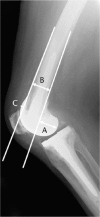Posterior condylar offset is an independent predictor of functional outcome after revision total knee arthroplasty
- PMID: 28360083
- PMCID: PMC5376661
- DOI: 10.1302/2046-3758.63.BJR-2015-0021.R1
Posterior condylar offset is an independent predictor of functional outcome after revision total knee arthroplasty
Abstract
Objectives: Preservation of posterior condylar offset (PCO) has been shown to correlate with improved functional results after primary total knee arthroplasty (TKA). Whether this is also the case for revision TKA, remains unknown. The aim of this study was to assess the independent effect of PCO on early functional outcome after revision TKA.
Methods: A total of 107 consecutive aseptic revision TKAs were performed by a single surgeon during an eight-year period. The mean age was 69.4 years (39 to 85) and there were 59 female patients and 48 male patients. The Oxford Knee Score (OKS) and Short-form (SF)-12 score were assessed pre-operatively and one year post-operatively. Patient satisfaction was also assessed at one year. Joint line and PCO were assessed radiographically at one year.
Results: There was a significant improvement in the OKS (10.6 points, 95% confidence interval (CI) 8.8 to 12.3) and the SF-12 physical component score (5.9, 95% CI 4.1 to 7.8). PCO directly correlated with change in OKS (p < 0.001). Linear regression analysis confirmed the independent effect of PCO on the OKS (p < 0.001) and the SF-12 physical score (p = 0.02). The overall rate of satisfaction was 85% and on logistic regression analysis improvement in the OKS (p = 0.002) was a significant predictor of patient satisfaction, which is related to PCO; although this was not independently associated with satisfaction.
Conclusion: Preservation of PCO should be a major consideration when undertaking revision TKA. The option of increasing PCO to balance the flexion gap while maintaining the joint line should be assessed intra-operatively.Cite this article: N. D. Clement, D. J. MacDonald, D. F. Hamilton, R. Burnett. Posterior condylar offset is an independent predictor of functional outcome after revision total knee arthroplasty. Bone Joint Res 2017;6:172-178. DOI: 10.1302/2046-3758.63.BJR-2015-0021.R1.
Keywords: Arthroplasty; Condylar offset; Knee; Outcome; Revision.
© 2017 Clement et al.
Conflict of interest statement
Figures



Similar articles
-
A computational simulation study to determine the biomechanical influence of posterior condylar offset and tibial slope in cruciate retaining total knee arthroplasty.Bone Joint Res. 2018 Jan;7(1):69-78. doi: 10.1302/2046-3758.71.BJR-2017-0143.R1. Bone Joint Res. 2018. PMID: 29330345 Free PMC article.
-
Recall of preoperative Oxford Hip and Knee Scores one year after arthroplasty is an alternative and reliable technique when used for a cohort of patients.Bone Joint Res. 2018 Jun 5;7(5):351-356. doi: 10.1302/2046-3758.75.BJR-2017-0259.R1. eCollection 2018 May. Bone Joint Res. 2018. PMID: 29922455 Free PMC article.
-
Interactive effect of femoral posterior condylar offset and tibial posterior slope on knee flexion in posterior cruciate ligament-substituting total knee arthroplasty.Knee. 2018 Mar;25(2):335-340. doi: 10.1016/j.knee.2018.02.001. Epub 2018 Mar 7. Knee. 2018. PMID: 29525547
-
The role of joint line position and restoration of posterior condylar offset in revision total knee arthroplasty : a systematic review of 422 revision knees arthroplasty.Acta Orthop Belg. 2021 Sep;87(3):453-460. Acta Orthop Belg. 2021. PMID: 34808719
-
Similar postoperative patient-reported outcome in both second generation patellofemoral arthroplasty and total knee arthroplasty for treatment of isolated patellofemoral osteoarthritis: a systematic review.Knee Surg Sports Traumatol Arthrosc. 2019 Jul;27(7):2226-2237. doi: 10.1007/s00167-018-5151-8. Epub 2018 Sep 28. Knee Surg Sports Traumatol Arthrosc. 2019. PMID: 30264243
Cited by
-
Impact of Tibial Tubercle Osteotomy on Final Outcome in Revision Total Knee Arthroplasty: Our Experience and Technique in Pakistan.Clin Orthop Surg. 2021 Mar;13(1):53-59. doi: 10.4055/cios20057. Epub 2020 Dec 8. Clin Orthop Surg. 2021. PMID: 33747378 Free PMC article.
-
The negative effect of joint line elevation after total knee arthroplasty on outcome.Knee Surg Sports Traumatol Arthrosc. 2019 May;27(5):1477-1486. doi: 10.1007/s00167-018-5099-8. Epub 2018 Aug 14. Knee Surg Sports Traumatol Arthrosc. 2019. PMID: 30109369 Free PMC article.
-
Is there a difference in joint line restoration in revision Total knee arthroplasty according to prosthesis type?BMC Musculoskelet Disord. 2018 Oct 20;19(1):382. doi: 10.1186/s12891-018-2295-0. BMC Musculoskelet Disord. 2018. PMID: 30342515 Free PMC article.
-
Survival and functional outcome of revision total knee arthroplasty with a total stabilizer knee system: minimum 5 years of follow-up.Eur J Orthop Surg Traumatol. 2019 Oct;29(7):1511-1517. doi: 10.1007/s00590-019-02449-9. Epub 2019 May 25. Eur J Orthop Surg Traumatol. 2019. PMID: 31129718
-
Mid-term results and survival rates following a single-design rotating hinge knee arthroplasty in non-tumor conditions in a Pakistani population.Knee Surg Relat Res. 2021 May 4;33(1):15. doi: 10.1186/s43019-021-00102-6. Knee Surg Relat Res. 2021. PMID: 33947473 Free PMC article.
References
-
- Culliford DJ, Maskell J, Beard DJ, et al. Temporal trends in hip and knee replacement in the United Kingdom: 1991 to 2006. J Bone Joint Surg Br 2010;92-B:130-135. - PubMed
-
- No authors listed. NHS Scotland Scottish Arthroplasty Annual Report 2010. http://www.arthro.scot.nhs.uk/Reports/Scottish_Arthroplasty_Project_Repo.... In: 2010. (date last accessed 22 January 2017)
-
- Friedman RJ, Poss R. Revision total knee arthroplasty in patients with osteoarthritis. Rheum Dis Clin North Am 1988;14:537-544. - PubMed
-
- Babazadeh S, Dowsey MM, Swan JD, et al. Joint line position correlates with function after primary total knee replacement: a randomised controlled trial comparing conventional and computer-assisted surgery. J Bone Joint Surg Br 2011;93-B:1223-1231. - PubMed
-
- Partington PF, Sawhney J, Rorabeck CH, et al. Joint line restoration after revision total knee arthroplasty. Clin Orthop Relat Res 1999:165-171. - PubMed
LinkOut - more resources
Full Text Sources
Other Literature Sources
Miscellaneous

